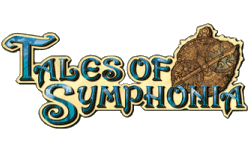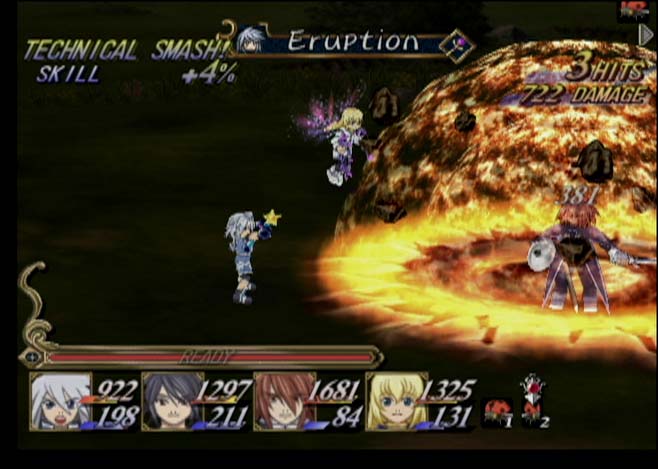|
|

|
BATTLE SYSTEM
|

|
INTERACTION
|

|
ORIGINALITY
|

|
STORY
|

|
MUSIC & SOUND
|

|
VISUALS
|

|
CHALLENGE
|
Easy/Variable
|
COMPLETION TIME
|
40-70 hours
|
|
OVERALL
4/5
|
Rating definitions
|
|
|
With mana on the decline and the world falling into despair, it is up to the Chosen and her companions to go on a journey of regeneration to save the world. Tales of Symphonia combines developed characters and an exciting battle system to create a very good game. It's also a good choice for completionists and anyone looking for a game with a high replay value.
Since enemies appear on the overworld and dungeon maps, it is possible to avoid battles. When an enemy catches the group of heroes, however, the player takes control of a single character while the AI or other players control the rest. Unlike many other RPGs, the AI is quite good and requires little babysitting, aside from some occasional customization. Most of the action is controlled using the control stick, a few buttons for basic actions like attacking and blocking, and shortcuts that allow special moves to be performed without accessing the menu. With the exception of using items, this eliminates nearly any need to enter the battle menu and speeds up battles dramatically. If multiple characters attack an enemy at once, they will often combine their efforts into a combo. When healing is needed, it is possible to cook various foods between battles which vary in potency and effect. Outside of battle, it is possible to perform a multitude of other character customizations, including level-up bonus adjustment, skill tree manipulation, and the changing of equipment.
On the default difficulty, normal battles are fairly easy as few enemies pose a real threat. Players are more likely to concern themselves with earning a high grade than worrying about death. Boss fights are generally a large leap in difficulty, but are rarely hard enough to cause any major problems for the party. It is possible to increase the difficulty, but this mainly results in the HP of enemies skyrocketing, though it effects other stats to a lesser degree as well. The ability to change difficulty settings seems to have been added for replay or a quick challenge, rather than for first playthrough purposes.
 Action-packed battles
Action-packed battles
|
|
With the amount of information to be found within the main menu, it can be difficult to find what the player is looking for at first, but the menu is excellent once the player becomes used to it. It lists recently obtained items, map locations, training tips, and much more for the convenience of the player. If a character is afflicted with a status effect, it will even have the recommended items flash so they are easy to locate. The controller setup system, replete with shortcut customization, helps the game move very smoothly. Like the helpful menu scheme, the localization contains only a few errors and plays out through the game very well.
Unfortunately, the game is lacking in originality. The battle system is simply a tweaked version of the same one that appeared in other Tales games and some parts of the story are similar to other games such as Final Fantasy X. It does have a few interesting interface and battle system tweaks, but it's still unoriginal overall.
While the plot lacks originality, it is brought to life by a fairly large cast of developed characters. Throughout the game there are a number of optional skits that allow the player to hear about important plot points from the point of view of various party members. There are also quite a few sidequests that focus on character personality and development. This attention to character detail makes the story much more enjoyable as a whole. The plot itself doesn't develop nearly as much as the characters, but still manages to pick up a bit towards the end. Had there been as much attention to the plot as there was to the characters, the result would have been much better.
While the story isn't incredibly developed, it is still rather lengthy. Players are sent to a large number of interesting dungeons complete with their own set of puzzles. In addition to the main quest, there is also a tremendous wealth of sidequests that can keep players busy for quite a while. If the player ignores optional skits and sidequests, it's still likely to take about forty hours to finish the game; however, the sheer numbers of additional events can easily add another twenty or thirty hours. There is also a replay mode which can add a considerable amount of extra time as well.
 Floating in the sky...
Floating in the sky...
|
|
Most of the background music, especially battle music, is very well done. Battle and overworld tracks are even changed after a while to prevent them from getting repetitive. Unfortunately this is not the case with most dungeon music and a few other tracks that are repeated throughout the game. After forty plus hours, some of these tracks become a bit stale. Most of the sound effects are good, though there are a few that don't seem to fit, such as the summoning chime. All that, in addition to the largely above average voice acting, gives the aural experience of Tales of Symphonia excellence without complete perfection.
Most of the game features beautiful 3D graphics and animated character portraits. In battle, each character model, ally and enemy alike, has a wide range of impressive animation. There are only a few pallette-swaps, and most of them are at least a dozen hours apart. Sadly, the enemy models that represent groups of monsters on the overworld and dungeon maps are somewhat blocky and lack variety. To help make up for this, there are a few FMVs and anime cutscenes, which are mostly excellent. While slightly flawed, the visuals are generally beautiful.
Tales of Symphonia has action-packed battles and a developed cast of characters. While it isn't very original, it manages to take some of the best elements of other games and combine them effectively to create a great game. The music and graphics are good, the replay potential is substantial, and the game even has the added bonus of a multiplayer option. While it could have been better, Tales of Symphonia is still a great game.
Review Archives
|









